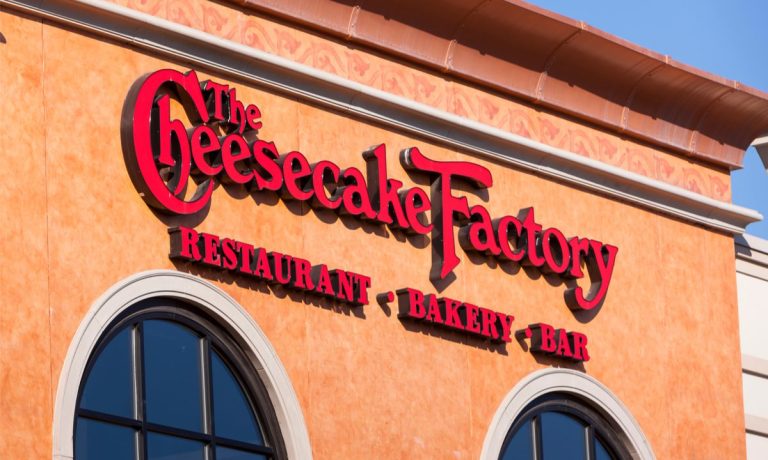
The Cheesecake Factory, known for its full-service dining experience, has been permanently changed by the rise in off-premise. The Calabasas, California-based chain, which operates over 300 restaurants in the United States and Canada, shared with analysts on a call Wednesday (Nov. 3) discussing the restaurant’s third quarter results that off-premise sales remain almost twice what they were pre-pandemic, with these ordering channels bringing new customers into the fold.
“We recently completed a consumer research study that showed that we attracted a significant number of new guests to the Cheesecake Factory throughout COVID, particularly via the off-premise channel,” the chain’s president, David Gordon, said. “Notably, loyalty is very strong, evidenced by a significant number of these new guests already in the frequent cohort. This data further reinforces our belief that a meaningful increase in off-premise sales could be a longer term sales driver for the Cheesecake Factory, as we emerge from the pandemic.”
PYMNTS’ research from the How We Eat Playbook, created in collaboration with Carat, from Fiserv, finds that consumers now are 31% more likely to buy meals for delivery or pickup than they are to dine on-site. Specifically, 67% of restaurant customers report opting for the former, compared to just 51% choosing the latter.
See also: Up for Grabs: Restaurants and Grocers See Path to Picking up 200 Million New Customers
Additionally, the chain’s EVP and CFO Matthew Clark shared that the chain remains on track to launch its loyalty app at some point in 2022. PYMNTS’ research from the 2021 Restaurant Readiness Index, created in collaboration with Paytronix, finds that consumers rank the availability of rewards programs as the top feature that would make them inclined to spend more on their food orders, ahead of the ability to order online and the ability to pick up orders without standing in line.
Read more: QSRs’ Lagging Loyalty-Reward Investment Hurts Innovation And Sales
In fact, the study found that restaurant managers undervalue the impact of loyalty rewards on consumers, with only 36% of the former group reporting that they believe these programs will be important to restaurants’ future success, compared to 51% of the latter.
Counter to Industry-Wide Trends, Wingstop Sees Delivery Growth
Also in earnings news, Wingstop shared with analysts on a call Wednesday discussing the chain’s third quarter results, that at a time when most brands are touting their ability to retain the majority of their mid-pandemic delivery growth, the chicken wing chain’s delivery volume continues to increase. Delivery sales were up three points year-over-year, and company leaders view this as an opportunity to reduce costs by remaining a predominantly off-premise business.
“From a dining room perspective, we still only have about 200 restaurants, plus or minus, that have their dining rooms open today, out of 1,500 in the U.S.,” said Charlie Morrison, the restaurant’s chairman and CEO. “And so that’s a good indication to us that we can further simplify our model by reducing the size of the dining rooms and leveraging the strong delivery business that we’re seeing.”
Chicken wings have been so popular since the start of the pandemic, given their delivery-friendly appeal, that earlier this year, Wingstop responded to consequent chicken wing shortages by opening a new, virtual brand, Thighstop, serving thighs instead.
For more: Wingstop’s New Virtual Brand ‘Thighstop’ Turns Chicken Shortage Into Opportunity
“In September, we integrated thighs into our regular Wingstop menu, doubling our thigh sales and allowing us to further progress on our strategy of buying more parts of the bird,” Morrison said.
Dickey’s Barbecue Pit Supercharges Its Virtual Kitchen Efforts with GKB Partnership
Another restaurant looking to lean on its delivery success to find more CapEx-efficient ways to drive sales is Dickey’s Barbecue Pit, which announced Wednesday that it is partnering with Toronto-based virtual restaurant company Ghost Kitchen Brands to open restaurants in over 100 U.S. locations.
“We are beyond excited to partner with Ghost Kitchen Brands and expand our availability to our fans,” Laura Rea Dickey, CEO of Dickey’s Barbecue Restaurants, said in a statement. “Dickey’s is committed to constantly evolving with consumer trends, and Ghost Kitchen Brands’ innovative model provides another opportunity for us to stay ahead of the curve.”
In a September interview with Karen Webster, Marc Choy, president of Ghost Kitchen Brands, argued that virtual locations capture the rising demand for restaurant meals, as consumers increasingly seek alternatives to cook-at-home options.
“The dynamic of the 1950s, where somebody would cook six square meals a week and maybe go out once a week, is going to be totally the opposite,” said Choy. “This is how people are going to know how to get their food — by ordering.”
Related news: In-Store Ghost Kitchens Turn Walmart Into Uber Eats Competitor
Cava Gets in on Digital Catering Rush
At the start of the pandemic, as the bulk of restaurant ordering switched to online channels, catering businesses were largely left out of the digital shift. This omission made sense at the time, since many consumers were steering clear of large, group occasions, but as social gatherings have returned, catering businesses have been rushing to catch up.
On Monday (Nov. 1), Cava, a Washington, D.C.-based fast-casual brand with over 100 locations across the United States, launched its omnichannel catering business at a New York City location, with plans for a nationwide rollout in 2023, QSR reported Tuesday (Nov. 2).
The launch came about a month after digital ordering platform BentoBox launched its Pre-Order & Catering product, highlighting the lack of digital tools for restaurants looking to offer catering online, and after Instacart announced that it is acquiring catering software company FoodStorm.
You may also like: As Takeout and Delivery Soar, Catering Businesses Have Been Left Behind in the Digital Shift